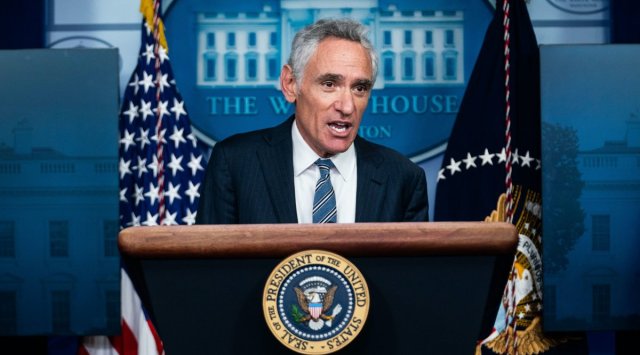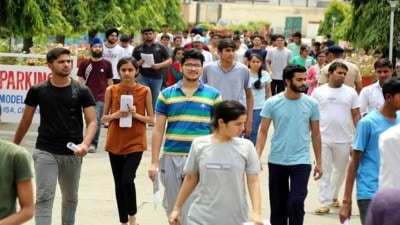- India
- International
A viral theory cited by US health officials draws fire from scientists
While Atlas and administration officials have denied advocating this approach, they have praised the ideas in the declaration. The message is aligned with Trump’s vocal opposition on the campaign trail to lockdowns, even as the country grapples with renewed surges of the virus.
 Scott Atlas is President Donald Trump’s science adviser, a powerful force inside the White House.(Anna Moneymaker/The New York Times)
Scott Atlas is President Donald Trump’s science adviser, a powerful force inside the White House.(Anna Moneymaker/The New York Times)Written by Apoorva Mandavilli and Sheryl Gay Stolberg
As the coronavirus pandemic erupted this spring, two Stanford University professors — Dr. Jay Bhattacharya and Dr. Scott W. Altas — bonded over a shared concern that lockdowns were creating economic and societal devastation.
Now Atlas is President Donald Trump’s science adviser, a powerful force inside the White House. And Bhattacharya is one of three authors of the Great Barrington Declaration, a scientific treatise that calls for allowing the coronavirus to spread naturally in order to achieve herd immunity — the point at which enough people have been infected to stall transmission of the pathogen in the community.
While Atlas and administration officials have denied advocating this approach, they have praised the ideas in the declaration. The message is aligned with Trump’s vocal opposition on the campaign trail to lockdowns, even as the country grapples with renewed surges of the virus.
The central proposition, supported by some 40,000 signatories, is that to contain the coronavirus, people “who are not vulnerable should immediately be allowed to resume life as normal” while those at high risk are protected from infection.

Younger Americans should return to workplaces, schools, shops and restaurants, while older Americans would remain cloistered from the virus as it spreads, receiving such services as grocery deliveries and medical care.
Eventually so many younger Americans will have been exposed, and presumably will have developed some immunity, that the virus will not be able to maintain its hold on the communities, the declaration contends.
But it does not offer details on how the strategy would work in practice. Dr. Anthony Fauci, the government’s top infectious disease expert, has dismissed the declaration as unscientific, dangerous and “total nonsense.” Others have called it unethical, particularly for multigenerational families and communities of color.
Alarmed and angry, 80 experts Wednesday published a manifesto of their own, the John Snow Memorandum (named after a legendary epidemiologist), saying that the declaration’s approach would endanger Americans who have underlying conditions that put them at high risk from severe COVID-19 — at least one-third of U.S. citizens, by most estimates — and result in perhaps a half-million deaths.
“I think it’s wrong, I think it’s unsafe, I think it invites people to act in ways that have the potential to do an enormous amount of harm,” said Dr. Rochelle Walensky, an infectious disease expert at Harvard University and one of the signatories to the Snow memo. “You don’t roll out disease — you roll out vaccination.”
The declaration grew out of a gathering hosted in Great Barrington, Massachusetts, by the American Institute for Economic Research, a think tank dedicated to free-market principles that partners with the Charles Koch Institute, founded by the billionaire industrialist to provide support to libertarian-leaning causes and organizations.
On Oct. 5, the day after the declaration was made public, the three authors — Bhattacharya, Sunetra Gupta of Oxford University and Martin Kulldorff of Harvard — arrived in Washington at the invitation of Atlas to present their plan to a small but powerful audience: the health and human services secretary, Alex Azar.
Over the course of an hourlong meeting in a wood-paneled, sixth-floor suite atop the health department’s headquarters, the researchers walked the secretary and Atlas through their thinking.
Azar later tweeted: “We heard strong reinforcement of the Trump Administration’s strategy of aggressively protecting the vulnerable while opening schools and the workplace.”
Battered by lost jobs, pandemic fatigue and isolation, and worried for their children, there is little doubt that Americans loathe lockdowns, although many still see them as necessary to control the virus.
Among scientists, too, there is near-universal agreement that lockdowns are harmful. Even Fauci has suggested that another national lockdown must be instituted only as a last resort.
But mostly, scientific disagreement centers on whether lockdowns are a necessary move when other strategies to contain the virus have not even been put in place, or have failed.
“This has been wrongly framed as a debate between lockdown and no lockdown,” said Dr. Deepti Gurdasani, a clinical epidemiologist at Queen Mary University of London.
Dr. David Nabarro, a special envoy to the World Health Organization, has urged governments not to resort to lockdowns as the primary method to control the virus. Masks, social distancing, fewer crowds, testing and tracing — these are the ways to control the virus in the long run, he said in an interview.
But the lockdowns in the spring were necessary, he added, as emergency measures to give countries time to put in place strategies to control the virus.
“There is a middle way,” Nabarro added, between strict lockdowns and letting the virus freely infect people. “If only we had a few more world leaders who would understand this, we wouldn’t have this debate going on.”
But Bhattacharya and his supporters go further. They say that governments should never have imposed lockdowns at all, and never should have tried to institute coronavirus testing and contact-tracing.
The manifesto’s central tenet is that young people should be free to resume normal life — to reenter the workforce, attend college, dine in restaurants. They would become infected, hopefully without much illness, and gain immunity.
Eventually the virus would not be able to find new victims and would fade away.
But some experts said the strategy was highly impractical, given the difficulty in determining who is truly susceptible. The risk of death from COVID-19 rises sharply with age, but about 37% of adults in America also are at significant risk because of obesity, diabetes or other underlying conditions.
The most recent statistics indicate that 20% of deaths from COVID-19 occur in people under age 65. And about a third of people who have recovered from the disease, including the young, still struggle with symptoms weeks later (a phenomenon the Barrington authors contest). “It’s amazingly irresponsible” not to take these risks into account, Nabarro said.
Scientists who have signed the declaration did not offer many details for putting its ideas in place.
“I don’t know exactly how it would work,” said Gabriela Gomes, a mathematical modeler at the University of Strathclyde in Britain and one of 42 co-signers.
Another supporter, Paul McKeigue, a genetic epidemiologist at the University of Edinburgh in Scotland, said, “Specific control measures for preventing coronavirus transmission are not my area of expertise.”
The lack of a clear plan has turned away even some would-be supporters. Dr. Stefan Baral, an epidemiologist at the Johns Hopkins Bloomberg School of Public Health, attended part of the Great Barrington, Massachusetts, meeting and said he was sympathetic to the effort.
But Baral, a Swedish citizen who supports that country’s approach, said he did not sign the declaration because it did not lay out a plan for workplace or housing accommodations for people at risk.
Sweden adopted an unrestrictive approach, offering guidelines to its citizens but leaving compliance up to them. The country is often cited as the model for controlling the virus without restrictions, but has among the highest death rates in the world, particularly among the elderly. It has also suffered economic losses comparable to those of other Nordic countries.
The town of Great Barrington, Massachusetts, home to the American Institute for Economic Research, recently distanced itself from the declaration, saying the strategy it proposed could “cost millions of lives.”
“Anyone who might avoid Great Barrington, due to confusion over the Declaration, is invited to visit and see how COVID-safe works in a small New England town,” the town’s leaders wrote.
“Please wear a mask.”
Apr 18: Latest News
- 01
- 02
- 03
- 04
- 05






































